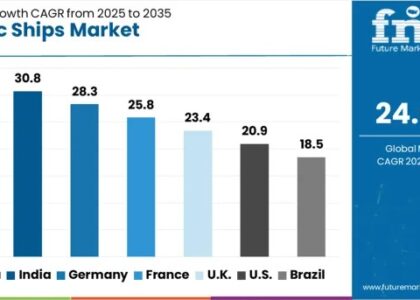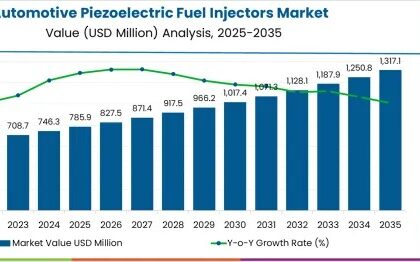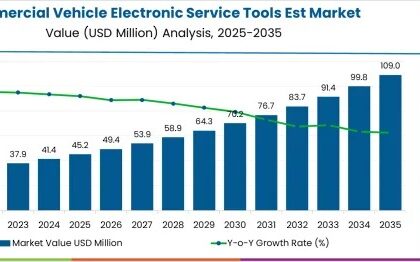In 2023, the global mineral wool market is poised to attain a valuation of US$ 15.1 billion, driven by the expanding energy and power sectors, which contribute to the market’s robust growth prospects. Projections suggest a Compound Annual Growth Rate (CAGR) of 4.3% from 2023 to 2033, culminating in an estimated market worth of approximately US$ 23.0 billion by 2033. This anticipated expansion underscores the increasing demand for mineral wool across various industries, propelled by its exceptional insulation properties and its role in enhancing energy efficiency and sustainability in construction and industrial applications worldwide.
Germany’s commitment to sustainable construction practices, notably the adoption of eco-friendly and recyclable materials, positions mineral wool as a favorable choice due to its composition of natural or recycled materials, aligning with environmental objectives. This emphasis on sustainable building materials is anticipated to propel the mineral wool market’s growth within Germany, with the country forecasted to maintain a Compound Annual Growth Rate (CAGR) of 4.1% throughout the forecast period. Such trends underscore Germany’s role as a key driver in promoting eco-conscious construction practices and fostering the adoption of environmentally friendly insulation solutions like mineral wool.
Request Sample Report: http://www.futuremarketinsights.com/reports/sample/rep-gb-4317
Growth Drivers:
- Energy Efficiency Regulations: Increasing emphasis on energy efficiency in buildings, driven by stringent regulations and sustainability goals, has propelled demand for insulation materials like mineral wool, which offer excellent thermal properties.
- Construction Industry Growth: The booming construction industry, particularly in developing economies, has led to rising demand for insulation materials for both residential and commercial buildings, thereby driving the mineral wool market.
- Urbanization and Industrialization: Rapid urbanization and industrialization have led to the construction of new infrastructure and buildings, creating a sustained demand for insulation materials to enhance energy efficiency and occupant comfort.
- Renewable Energy Projects: Growing investments in renewable energy projects, such as wind and solar power, require insulation materials for equipment and facilities, contributing to the expansion of the mineral wool market.
- Advancements in Material Technology: Ongoing research and development efforts have led to the development of advanced mineral wool products with enhanced performance characteristics, attracting consumers seeking more efficient insulation solutions.
- Awareness of Environmental Benefits: Increasing awareness regarding the environmental benefits of mineral wool, such as its recyclability and low embodied energy, has encouraged its adoption as a sustainable insulation material.
Industry Restraints:
- Competition from Alternative Materials: The mineral wool market faces competition from alternative insulation materials, such as foam boards and spray foam, which offer different performance characteristics and may sometimes be preferred due to cost or specific application requirements.
- Volatility in Raw Material Prices: Fluctuations in the prices of raw materials used in the production of mineral wool, such as silica, basalt, and recycled glass, can impact production costs and ultimately affect the market dynamics.
- Health and Safety Concerns: Despite improvements in safety standards, concerns persist regarding the health and safety implications of mineral wool fibers, particularly during installation and handling, which could potentially limit its adoption in certain applications.
- Market Saturation in Mature Regions: In mature markets, such as North America and Europe, the mineral wool market may experience saturation, leading to intensified competition and pricing pressures, unless differentiated products or market segments are targeted.
- Regulatory Challenges: Compliance with evolving regulatory standards related to environmental protection, product safety, and energy efficiency poses challenges for manufacturers in the mineral wool industry, requiring continuous adaptation and investment in R&D.
- Supply Chain Disruptions: Disruptions in the supply chain, whether due to geopolitical tensions, natural disasters, or logistical challenges, can affect the availability of raw materials and finished products, impacting the stability of the mineral wool market.
The Key Players:
The prominent players for the global mineral wool market includes
- Saint-Gobain S.A.,
- ROXUL ROCKWOOL Technical Insulation,
- Knauf Insulation,
- Industrial Insulation Group LLC.
Mineral wool is made from the resource which is abundant in nature and is energy efficient. Mineral wool market is majorly driven by the industrial applications where the mineral wool is used as an insulation and filler. It is also used as acoustical solution as a noise barrier in the areas where noise levels are high than the desired noise level prescribed as per government regulations.
Request Customization: https://www.futuremarketinsights.com/customization-available/rep-gb-4317
Key Segmentations:
By Type:
- Glass
- Rock
- Slag
By Application:
- Construction
- Transportation
- Industrial
- Residential
- Sound Absorbers
- Emission Control
- Acoustical
- Fire-Proofing
The Western Europe is the leading region for the demand of mineral wool market due to rising demand for the insulation from the Germany owing to rapid investment in the building renovation program. Europe in order to strengthen its economic stability post 2012 crises led to increased mineral wool consumption for various industrial and commercial applications. North America, being second in the mineral wool market position after Europe, contributes significant share in the growth of mineral wool market. Owing to tightened regulations about the insulation thickness and increase in demand from the automotive industry, the North America market is expected to propel the demand for the global mineral wool market.
About Future Market Insights (FMI)
Future Market Insights, Inc. (ESOMAR certified, recipient of the Stevie Award, and a member of the Greater New York Chamber of Commerce) offers profound insights into the driving factors that are boosting demand in the market. FMI stands as the leading global provider of market intelligence, advisory services, consulting, and events for the Packaging, Food and Beverage, Consumer, Technology, Healthcare, Industrial, and Chemicals markets. With a vast team of over 5000 analysts worldwide, FMI provides global, regional, and local expertise on diverse domains and industry trends across more than 110 countries.
Contact Us:
Future Market Insights Inc.
Christiana Corporate, 200 Continental Drive,
Suite 401, Newark, Delaware – 19713, USA
T: +1-845-579-5705
For Sales Enquiries: sales@futuremarketinsights.com
Website: https://www.futuremarketinsights.com
LinkedIn| Twitter| Blogs | YouTube






